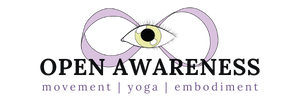05 Apr Principles of Open Awareness: Grounding
We’re well into April and on to another monthly theme: principles of Open Awareness.
Last month we talked about yoga philosophy from the Yoga Sutras of Patanjali and I tried to stay as true to traditional interpretation as possible. After all, these roots are what makes it yoga that we’re practicing and not some other kind of mindful movement. For more, click each link to read about yama, niyama, asana, and pranayama.
This month I’m sharing from my own playbook. The blueprint and foundation of Open Awareness is yoga, however, my practice spans many modalities and approaches.
I’ve picked out four guiding principles for us to investigate each week this month: grounding, centering, experimenting and exploring, and expansive breathing (it always comes back to the breath).
Let’s start from the bottom…
Grounding
Take a moment, don’t change a thing, and notice the parts of your body that are planted. Are your feet down? Your tush? Body contact with a chair counts! Don’t change a thing. Keep your awareness on your body and keep reading.
If you had to choose…would you say you feel collapsed, slumping, heavy? Or propped, poised, tense? Or balanced with a mix of feeling physically steady and soft but energetic?
Donna Farhi, an experienced and innovative yoga teacher, teaches the concept of grounding in a beautiful way. She points out the different ways people hold their body in relationship to the earth. Each of them are differently grounded. They track with the three options I gave you above: collapsed, propped, and yield.
In a collapsed relationship to the earth, a person feels weighed down by gravity.
Low tone muscles make the body feel like it’s flopping or bowing down towards the earth like the weight of heavy snow on the branches of a winter tree. Instead of a sense of support from the earth, there’s a sense of heaviness, like this person has to work against forces that are pulling them down, down, down.
A propped relationship to the earth is the opposite. A propped person’s body is marked by high tone or contracted muscles.
Picture an alpha male business man with his chest puffed up, fists clenched, and shoulders tense like shoulder pads are in his suit coat. This person appears to be competing with gravity to win. There’s a sense of distrust of the ground’s support, and an overuse of energy to stay so forcefully propped.
The goldilocks grounded relationship to the earth Donna calls yield.
Like when you yield while driving, there’s a give and take. You slow down to look and are equally prepared to stop or go, depending on the needs of the situation. You’re in a flexible and participatory relationship to your context.
The same is true for a body that is yielding to the earth. There’s not a collapse, yet there’s a surrender to and receiving of the support beneath you. There’s an active component, too. Not a propped pushing away, but a vitality of energy between your living, breathing, mobile body and the stability of the ground beneath you.
Your muscles don’t have to do everything to keep you upright; they participate just enough and are ready to change tone depending on the needs of your situation.
Can you adjust your position right now and find a sense of yield?
Can you feel the give and take of your weight with gravity and the earth as your breath changes from inhale to exhale?
Tuning into this inherent reciprocity between the earth and myself brings me a sense of aliveness that I’m not always conscious of, unless I choose to bring it into my open awareness. Yet, it’s always there. I’m always supported, no matter what.
Working with this sense of groundedness is an ever present opportunity to embody balance, ease, and reciprocity.
We’ll experiment with collapsed, propped, and yield in class this week and play more with our bodies’ many possible relationships to gravity and the earth. I hope to see you there!
For more from Donna, I highly recommend her book Yoga Mind, Body & Spirit. She also has a robust online teaching platform – check it out!
Page image from Donna Farhi, Yoga Mind, Body & Spirit, p.36, Henry Holt and Company (2000).
